Goldfish Selecting and Rearing - Tosakin by Kendal
Tosakin are in my opinion as dependent on keeping as culling. Like the head growth varieties most are familiar with, the way a tosakin is kept and fed greatly affects the final shape of the fish.
However, tosakin grooming is the opposite in many ways of grooming the head growth breeds. Where one pushed head growth fish development forward with high-protein food and calories, one pulls a tosakin back by restricting the calories given and by limiting protein.
Water depth and even enclosure shape have can also have a dramatic effect on the final shape of the fish. From my experience, this point cannot be understated no matter how far fetched it may seem.
All this said, one cannot groom a tosakin with limited potential into a fine specimen. strict culling is essential. Hope does not make tosakin—only good genes followed by proper care will. Most fish will fail—this is why good tosakin are so rare and expensive.
I don’t believe culling can be discussed without addressing the simultaneous grooming practices.
Cull one: Against assymitry and deformities
Once the fry are free swimming, anything asymmetrical should be culled as it is seen. The practice of culling out any asymmetry will continue even as the fish are fully formed. The tosakin tail can twist or bend asymmetrically quite late in development. Proper keeping will limit this, but sometimes there is little one can do but watch a good fish go to ruin. As a tosakin grows, any asymmetry in the tail will compound—cull when noticed.
Cull two: Against divided and webbed tails
In the early stages of development the tosakin tail looks no different that that of any other fancy goldfish. The tail will slowly open over the course of a few months. Initial culling should not be based on how open the tail is, but rather be concentrated on the point where the two halves of the tail are joined.
When the tosakin fry are about .5” long, or as early as can be detected, split and webbed tails should be culled. A “webbed” tail is one where the two halves are fused partially—single tail splitting into two. From behind a webbed tail looks like and upside down “Y”.
Divided tails will show a notch. Webbed tails will come to a point and will always have a dark line where the to haves join. It is always beneficial to double check with a side view to insure what you think you are seeing is indeed there. After a few side checks you can confidently cull out webbed tails.
Sorry, i could not find pictures.
strengthen the peduncle
The tail will not open to the near 180° required to make a good tosakin tail flip until the tosakin is about 1”, which depending on your water temperature, can be between 60-90 days. During this period, the peduncle needs to be strengthened as much as possible before it has set. The reason being that once a tosakin’s tail starts to open, the tail will create tremendous drag. Often the fish will learn that it can get more thrust by twisting its tail or by favoring one side. If the peduncle is strengthened early, it can withstand the increasing drag and will stay straight as the tail opens.
As soon as the tosakin are free swimming, they need to be forced to swill constantly to build strong peduncles. This is accomplished by keeping them in shallow water with maximum surface area and in large groups. An air stone that creates a current can also be used to induce constant swimming. If fish are not swimming constantly, turn up the bubbles. The shape of the container is not important in the forced swimming stage and flat-bottomed rectangles tubs are common.
Cull three: Against pointed tails
As the tail is opening, one looks for the proper shape of the central lobe of the tail (the center backmost part of the tail). In order for a tosakin to have the proper flip, the central lobe must be wide in order to push the tail forward causing the flip. i would go as far as saying a broad and round central lobe in the most critical characteristic of a good tosakin and without it, the tail just won't look right and will not have a good flip.
The central lobe of a tosakin is round. If it comes to point, cull.
Most of the tosakin I have seen offered for sale have a pointed central lobe. The myth (sales pitch) is that tosakin don’t develop their tail shape and flip until the second or third year. This is nonsense. A tosakin should have a fully developed and flipping tail before it demelanizes at 2-6 months or 1.5”. A colored baby tosakin will have a form very close to that of an adult. If it does not look like a tosakin at 1.5”, it never will no matter how well you keep it.
Pointed tails have a fundamentally different shape. If a pointed tail were laid flat it would have the shape of a veil tail—triangle. By contrast, a rounded tail if it could be laid flat will make a near full circle. The wonderful problem with the circle-shaped tail is that there is not enough space on the oza/tail seat to accommodate the spreading rays and the tail flips.
A flipping tail is not uncommon in other top-view breeds with widely opened tails such as ranchu, broadtails, and butterflies. However the tosakin flip is not a flip the starts on the leading edge with the leading ray folding backwards as it does with a broadtail with a triangle shaped tail. The tosakin flip starts much farther back and at maturity will flip again so the leading ray of the tail is again in a forward facing-position.
Below are images depicting the ideal shape of a tosakin in the first three years. Note that in all stages the tosakin are supposed to fit inside an imaginary circle. As the tail increases in size, the body proportionally occupies less of the circle, but the circle is maintained. (Authors note: tosakin never fit in a circle. LOL. But the circle is the ideal one strives for.)

Rounded Lobe:Tosakin with a wide rounded central lobes as juveniles and as they will appear as an adult:

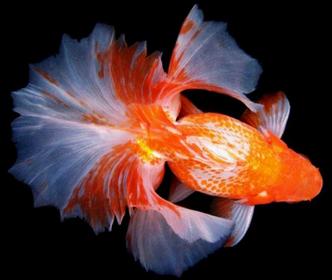
Triangle Tails:Tosakin with a pointed or triangle central lobe as juveniles and as they will appear as an adult:
Note how the tail does not flip so much as it just folds back in the adult.(Apologies to the owners of these fish/photos.)
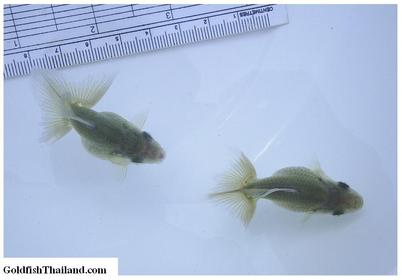
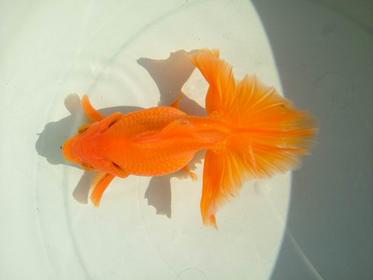
CULL FOUR: FOR OPENED TAILS (grooming the tail)
The last major culling event for tosakin takes place when the fish are about 1.5”. at this point the tail should be open to near 180° and show the beginnings of a tail flip. Tails that have not fully opened or are overly soft and collapse easily are culled.
At this stage the tosakin are moved to a round bowl with round bottom. From this point on tosakin are kept in water three times the depth of their body including the dorsal fin and with no more room to swim forward than about three to four times their length. A six inch fish can be kept in an 18-24” bowl. Where the bowl is larger than this ratio, more fish can be kept with the net effect being that the fish will hit another fish within 4 body lengths if evenly spread out. Four 3”fish can be kept in an 18-24” bowl. This is not an exact science. The goal is to keep the fish hovering in place rather than swimming forward which would bend and soften the tail. The round bottom and round shape of the bowl encourage the fish to swim nose up slowly around the parameter of the bowl in the same position as a fish feeding off the surface. This surface feeding position fans the tail out to its maximum spread. The more time a fish spends in this position, the more its tail will grow and stiffen in this shape. For this reason tosakin are often feed floating flake rather than sinking pellets thus training the fish to forage on the surface not the bottom.
Still water is needed and filtration and turbulence from air stones are to be avoided. Because of this and the relatively small amount of water in which the fish are kept, 100% daily water changes are mandatory to maintain water quality. Bowls should be kept out of direct sun as it can heat quickly and oxygen levels are diminished.
Last / misc. Cull: Tail set, eyes, nose, gills and missing anal fin.
A tosakin's tail is set flat in on the same line as the horizon. Though not intended for side viewing, the tosakin tail should be observed from the side to make the final tail-based culling decision. Tails that slope upwards will give the tosakin a tendency to do back flips when excited. The tail should also be tucked close to the body in order to fit in the imaginary circle.
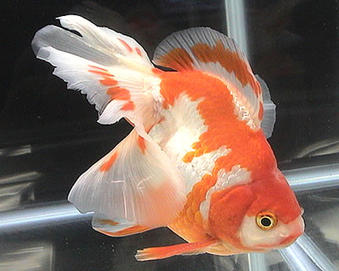
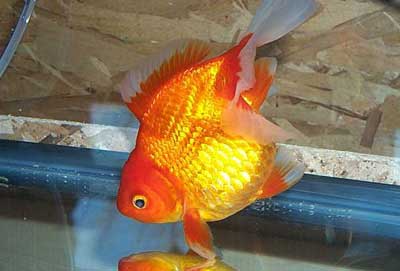
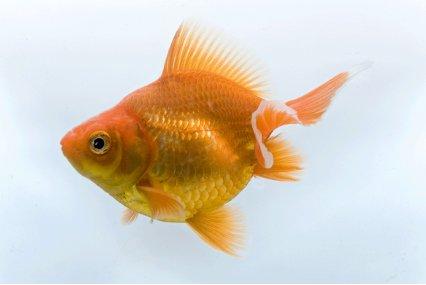
Bulging or overly large eyes are culled.
Broad heads are culled. The tosakin should have a very pointed head. This is more likely the result of grooming than genes. Tosakin are feed very sparingly and only low-protein food. This regime retards the growth of the body and head in favor of proportionally longer fins. If fed too much in the early stages, the head will be fat and blunt.
Tosakin are prone to gill deformations, particularly curled gill plates. Many keepers believe that gill flukes will cause the tosakin's gill plates to curl. My personal experience supports this belief. Tosakin should be treated regularly for flukes regardless of any evidence of an infection for at least the first two months. With the belief that curled opercula are the result of infection rather than genetics, fish with such a flaw can still be considered good seed fish, but such a flaw would be detrimental in a show.
Tosakin ideally have 2 anal fins, but a single fin is not a flaw. The absence of an anal fin however is grounds for culling. Note: the anal fin is believed to have a connection to the ratio of split, joined and webbed tails with single tails promoting webbed and double divided. Single anal fined fish are often bred to double anal finned fish to establish a balance. Single anal finned fish should not be crossed if it can be avoided.
Random notes:
When feeding, show restraint. Tosakin are fed comparatively very little and often not fed at all every 3-4 days. Vegetable-based foods are best
Color. Color has no bearing on selection. Tosakin are metallic red and white or green. Green/uncolored fish tend to have the largest tails and make good seeds fish for promoting large tails. Red self is the preferred color with red extending all the way to tail tips of the fins as a dark tail shows best in a white bowl, but most red fish have a white fringe on the tail and dorsal fins. Sakura fish tend to be very splotchy with a lot of streaking in the tail, which is very attractive. Tosakin tend to be darker red than many other breeds.
Hardiness. Tosakin are very hardy robust goldfish and fairly aggressive eaters and breeders. However the conditions in which they are kept are difficult to maintain. Poor water quality will however lead to weak and sickly fish.
Link to full developmental images:Original Link or PDF Extract






